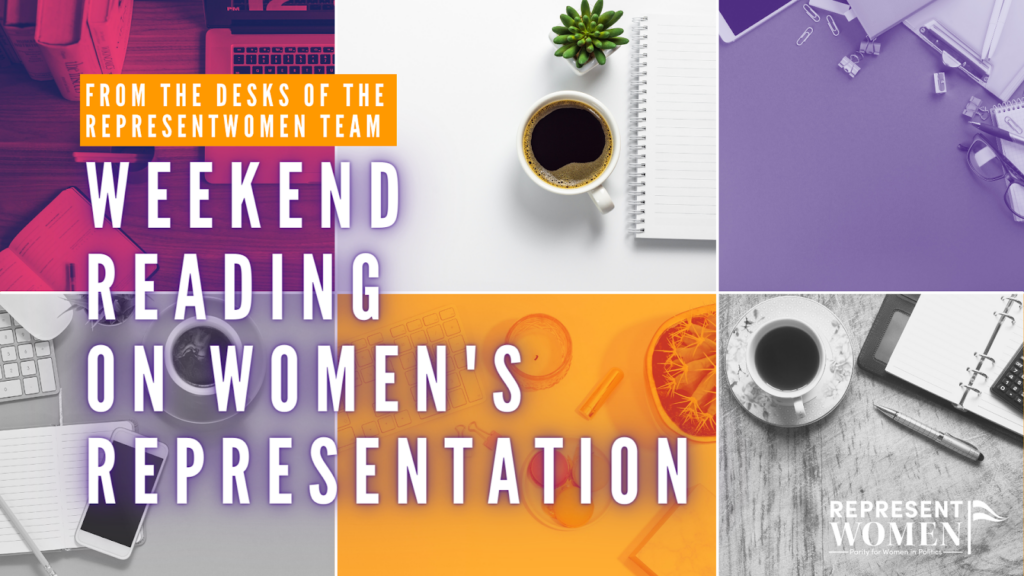Katie Usalis
-
Total Recruits50No recruits counted.
-
Katie Usalis published Report: 2022 Gender Parity Index in Research Library 2022-11-04 10:33:24 -0400
Report: 2022 Gender Parity Index

To quantify progress towards gender parity in elected and appointed office, RepresentWomen developed the Gender Parity Index (GPI). Each year, a Gender Parity Score and grade is calculated for each of the 50 states and for the United States as a whole. The Gender Parity Score reflects women's recent electoral successes at the local, state, and national levels on a scale of 0 (if no women were elected to any offices) to 100 (if women held all elected offices). The key advantage of the GPI is that it enables comparisons to be made over time and among states.
The 2022 Gender Parity Index
As of June 2022, there are 147 (28%) women in Congress: 24 in the Senate and 123 in the House. In 333 statewide elective executive offices, 101 (30%) are either led or co-led by women. Of 7,383 seats in state legislatures, women hold 2,295 (31%). At the local level, 367 (25%) of 1,465 cities are represented by women, and 80 (33%) of the five largest county governments in each state are either led or co-led by women.
And yet, overall progress towards parity is frustratingly incremental in the U.S. In 2022, the average parity score is 24.8. If we round up, this brings us to an average score of 25 out of 100, which means we are halfway to parity. In 2021, the average score was 24.6; two years ago, it was 23.8.
-
Katie Usalis published Report: PACs and Donors: Agents of Change for Women's Representation in Research Library 2022-11-03 15:00:04 -0400
Report: PACs and Donors: Agents of Change for Women's Representation
PACs should set funding targets for cis-women, transgender folk, and nonbinary candidates as well as increase those targets every election cycle until our elected bodies reflect the gender diversity of the population. With public pressure, equal funding for male, female, and genderqueer candidates may become a value proposition for PACs. The PAC environment is highly competitive and they are always looking for new ways to look different from other PACs to appeal to donors.
Read more about the breakdown of PAC giving in 2018 and our recommendations for PACs and donors in our 2020 PACs and Donors report.
-
Katie Usalis published Report: Achieving Gender Parity - Systems Strategies Around the World in Research Library 2022-11-03 14:51:29 -0400
Report: Achieving Gender Parity - Systems Strategies Around the World

In many countries around the world, women are entering political office at higher rates than in the United States. As of January 2022, the U.S. was tied with Egypt and the Philippines in 72nd place for the number of women (120 of 433, or 28%) in the lower legislature, the U.S. House of Representatives. Twenty years ago, there were half as many women in the U.S. House, and the country ranked 59th for women's representation.
In 2020, RepresentWomen released a report analyzing the impact electoral rules and systems have on women's representation. We found that countries with proportional systems and gender quotas were more likely to have women present in their national legislature. Our report, "Achieving Gender Parity: Systems Strategies Around the World," also introduces new research on women heads of state and government, women in executive cabinets around the world, the use of ranked-choice voting internationally, and the role women's representation has on democratic rankings.
-
Katie Usalis published Latinas Represent in Women's Representation Partners 2022-11-03 13:41:19 -0400
Latinas Represent
-
Video: Women LEAD
Embodying the phrase “if you can see it, you can be it,” normalizing women in political leadership positions will normalize the idea of women as leaders, period. Over the past decade, progress toward women’s legislative equality has been slow but present. While the number of women running for office and winning continues to be dwarfed by the number of men, there is an upward trajectory nearing the 30 percent threshold associated with the critical mass theory. Despite the growing numbers of women legislators, this progress does not automatically translate into women's uptick in executive or staff leadership positions. It's time we change that with intentional systems reforms. It's time we de-bug our democracy and let women lead.
-
Video: Women RUN
RepresentWomen's mission is to reform the institutions and structures that hold women back from running for office rather than forcing women to change. Increasing the recruitment, training, and funding of women candidates will be more effective in getting women elected at every level of government. It's time we dismantle these barriers for women who want to run for office.
-
Video: Women SERVE
The barriers women face do not end once elected. Congress, state legislatures, and local governments must modernize their internal practices and culture so that women legislators can serve and lead effectively. Erratic work schedules, low pay rates, geographic distance, and unfair leadership selection processes serve as a challenge for many women—especially those caring for relatives and managing households. Although these reforms would benefit men and women, these issues disproportionately affect women and will continue barring women from serving. It's time we change that. It's time we help women SERVE.
-
Katie Usalis published Video: How Does Ranked-Choice Voting Help Women? in Research Library 2022-11-03 10:43:08 -0400
Video: How Does Ranked-Choice Voting Help Women?
RepresentWomen tracks women's representation and leadership in the United States and around the world to identify the "best practices" for creating a more representative government. Our research indicates that even as more women run, electoral rules and systems play a major role in determining electoral outcomes. As seen in both our 2016 and 2020 reports, we find that electoral outcomes for women and people of color are overall better in jurisdictions that have implemented ranked choice voting (RCV).
-
Video: Women WIN
In January of 2021 with women holding 27 percent of the seats in the House of Representatives, the U.S. ranked 67th in the world for women’s representation in the lower house. Despite record-breaking election cycles the U.S. remains continually outpaced by 70+ countries including the majority of our democratic allies—allies that don’t have better women running, but better systems for women to run in and WIN. Ranked choice voting in multi-seat districts, commonly referred to as fair representation voting, is a form of proportional representation made to fit the United States’ electoral culture. The system combines the benefits for women found in both ranked choice voting and multi-member districts and corrects the problems of underrepresentation for communities of color which come with using multi-seat districts in a winner take all system. To normalize women leaders, and increase diversity in our politics. We need reform now.
-
Katie Usalis published Factsheet: Ranked Choice Voting FAQ in Research Library 2022-11-03 10:37:16 -0400
Factsheet: Ranked Choice Voting FAQ
This two-page RCV factsheet answers questions frequently asked regarding RCV. Some of these questions incude:
- What is RCV?
- Why does RepresentWomen support RCV?
- How do we know RCV helps women?
- Why is diverse representation important?
- Is RCV too complicated for voters?

A plain text version of this page is available here
-
Katie Usalis published The New Majority NYC in Women's Representation Partners 2022-11-03 08:32:00 -0400
The New Majority NYC
-
Report: Why Women Won in 2021

Released: September 2022
In 2022, we released a report on the outcome of the 2021 elections in New York City. RepresentWomen partnered with The New Majority NYC (formerly 21 in '21) to study 1) the impact of term limits, matching funds, ranked choice voting, and candidate-focused strategies on women's representation, 2) how these factors worked together to bring NYC a majority-women council for the first time in history, and 3) what it will take to maintain and build upon this success story in the future.
-
Katie Usalis published Weekend Reading on Women's Representation May 6, 2022 in Blog and OpEd Library 2022-05-16 09:31:56 -0400
Weekend Reading on Women's Representation May 6, 2022

Weekend Reading on Women’s Representation is a compilation of stories about women’s representation in politics, on boards, in sports and entertainment, in judicial offices and in the private sector in the U.S. and around the world—with a little gardening and goodwill mixed in for refreshment!
From teammate to teammate, the staff at RepresentWomen will give you our must-reads for women’s representation from this week.
Read more -
Katie Usalis published What Moms in Politics Really Want This Mother’s Day: Campaign-Funded Childcare in RepresentWomen in the News 2022-11-17 04:51:20 -0500
What Moms in Politics Really Want This Mother’s Day: Campaign-Funded Childcare
 Image source: New York Times
Image source: New York TimesBy Katie Usalis
This piece was originally published in Ms. Magazine, 5/6/2022
U.S. women are more likely to become moms now than they were a decade ago, Pew Research shows—which means we are seeing an increase of moms running for office. Just last week, Minnesota state Senate candidate Erin Maye Quade actually gave a campaign speech while in labor, where we can see her literally breathing through contractions at the podium. She eventually had to withdraw from the debate and her opponent won the party’s endorsement. What is it like to be a mother running for office?
Read moreToday in Minnesota, @ErinMayeQuade gave a convention speech while in active labor. And her opponent didn’t think to ask to postpone the convention as she, you know, had to go to the hospital to deliver her baby. What the hell. pic.twitter.com/Wmu5fh40I6
— ashley fairbanks (@ziibiing) April 24, 2022 -
Katie Usalis published Everything’s bigger in Texas, including the negative impact of runoffs on women candidates in RepresentWomen in the News 2022-04-15 16:15:21 -0400
Everything’s bigger in Texas, including the negative impact of runoffs on women candidates

By Katie Usalis
This was originally published in The Fulcrum on 4/15/2022.
Last month, Texas kicked off the midterm season with another batch of high-profile races going into a runoff — 23, to be exact.
Texas election law states that primary candidates must win with a majority, which becomes tricky when there are more than two candidates running. This results in an extraordinary amount of elections being forced into a runoff, where the top two candidates compete head-to-head in a second round of primary elections.
What’s so wrong with this? Two words: time and money. Both of which women candidates generally have less of.
Read more -
Katie Usalis published Justice Ketanji Brown Jackson’s Confirmation Will Bring About Dramatic Shifts in Power in RepresentWomen in the News 2022-04-11 10:29:35 -0400
Justice Ketanji Brown Jackson’s Confirmation Will Bring About Dramatic Shifts in Power

Ketanji Brown Jackson with staff members of Sen. Tina Smith (D-Minn.) on Capitol Hill April 4, 2022. (Kevin Dietsch / Getty Images)
By Katie Usalis
Originally published in Ms. Magazine, 4/7/2022
It’s official. It’s done. History has been made.
Justice Ketanji Brown Jackson is the first Black woman to be confirmed as a Supreme Court justice of the United States of America. She is also …
- The first Supreme Court justice raised by parents who grew up in the Jim Crow South.
- The first Supreme Court justice with an African name, given to express pride in the family’s heritage and hope for the future.
- The first Supreme Court justice who has served as a public defender.
Why do all these firsts matter, especially the ones that have nothing to do with her work as a judge? Let’s dive in.
Read more -
Katie Usalis published Our Democracy Has Problems. Women Have Solutions. in RepresentWomen in the News 2022-03-29 10:27:45 -0400
Our Democracy Has Problems. Women Have Solutions.

By Cynthia Richie Terrell and Jennifer Weiss-Wolf
Originally published in Ms. Magazine, 2/22/2022
These are trying times, no doubt. We have heard multiple well-informed people talk about plans to become self-reliant homesteaders because of “how things are going” in our country. Others have even casually mentioned that they have an escape plan lined up in case things “continue to go south.”
Read more